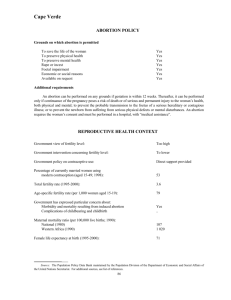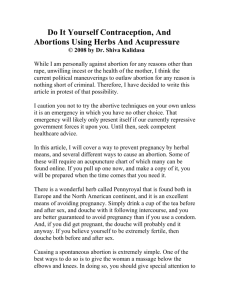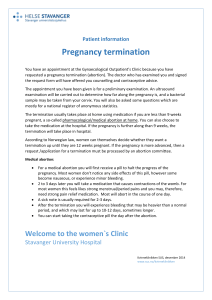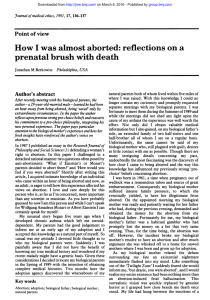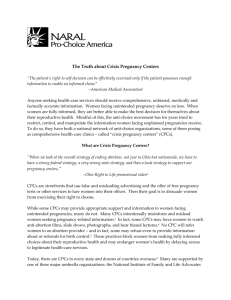Saudi Arabia - the United Nations
advertisement
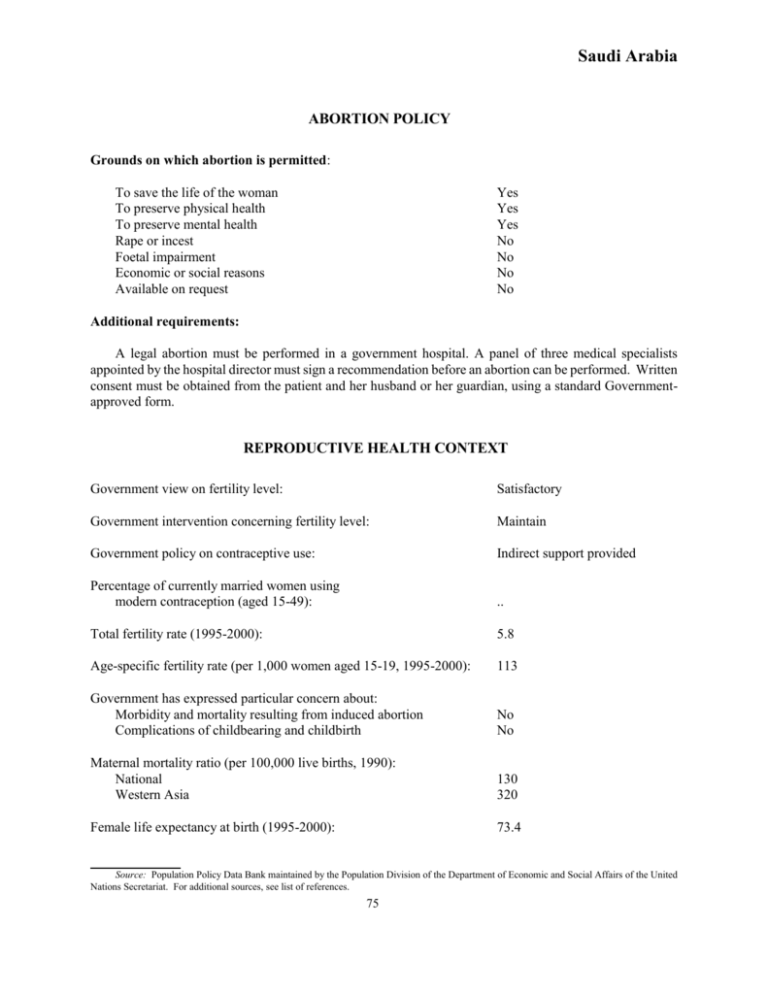
Saudi Arabia ABORTION POLICY Grounds on which abortion is permitted: To save the life of the woman To preserve physical health To preserve mental health Rape or incest Foetal impairment Economic or social reasons Available on request Yes Yes Yes No No No No Additional requirements: A legal abortion must be performed in a government hospital. A panel of three medical specialists appointed by the hospital director must sign a recommendation before an abortion can be performed. Written consent must be obtained from the patient and her husband or her guardian, using a standard Governmentapproved form. REPRODUCTIVE HEALTH CONTEXT Government view on fertility level: Satisfactory Government intervention concerning fertility level: Maintain Government policy on contraceptive use: Indirect support provided Percentage of currently married women using modern contraception (aged 15-49): .. Total fertility rate (1995-2000): 5.8 Age-specific fertility rate (per 1,000 women aged 15-19, 1995-2000): 113 Government has expressed particular concern about: Morbidity and mortality resulting from induced abortion Complications of childbearing and childbirth No No Maternal mortality ratio (per 100,000 live births, 1990): National Western Asia 130 320 Female life expectancy at birth (1995-2000): 73.4 Source: Population Policy Data Bank maintained by the Population Division of the Department of Economic and Social Affairs of the United Nations Secretariat. For additional sources, see list of references. 75 Saudi Arabia BACKGROUND Induced abortion is generally illegal in Saudi Arabia under non-codified principles of Islamic law. A person who performs an illegal abortion is subject to the payment of blood money to the relatives of the aborted foetus. However, under article 24 of the Rules of Implementation for Regulations of the Practice of Medicine and Dentistry, Ministerial Resolution No. 218/17/L of 26 June 1989, an abortion may be performed to save the pregnant woman’s life, and if the pregnancy is less than four months old and it is proven beyond doubt that continued pregnancy gravely endangers the mother’s health. Written consent of the patient and her husband or guardian is required. Article 24 is based on Resolution No. 140 by the Committee of Senior Ulema, which is reproduced in the above Rules and provides that a pregnancy cannot be aborted at any stage except when legally (according to Islamic Laws) justified and within very narrow limitations. Resolution No. 140 refers to three stages of pregnancy. Within the first 40 days of pregnancy, an abortion may be allowed if it is deemed necessary to accomplish a legal benefit or to prevent an expected harm. It is not allowed, however, for fear of hardship in child upbringing or inability to secure the cost of living, education, or future, or if the parents decide that they have enough children. At the embryo stage, an abortion is not allowed unless an approved medical committee decides that continuation of the pregnancy endangers the woman’s safety and could possibly lead to her death, and if all means to eliminate the danger have been exhausted. After four months of pregnancy, abortion is not allowed unless a panel of approved specialists states that continuation of the pregnancy will cause the woman’s death and all means to eliminate the danger have been exhausted. Resolution No. 140 provides that under these conditions, abortion is allowed “to avoid the gravest of two dangers and to accomplish the better of two benefits”. The Government of Saudi Arabia has not formulated a comprehensive policy that specifically considers population issues. However, because the Government views its population problems in the context of ensuring national identity and meeting its labour force requirements, it considers the rate of population growth to be too low and intervenes to increase population growth among its nationals. The Government views its comparatively high level of fertility as satisfactory but pursues a pronatalist policy. The total fertility rate has fallen from 6.8 children per woman (1985-1990) to 5.8 (1995-2000) and the population growth rate has also fallen over the same period from 4.8 per cent to 3.4 per cent. Source: Population Policy Data Bank maintained by the Population Division of the Department of Economic and Social Affairs of the United Nations Secretariat. For additional sources, see list of references. 76

